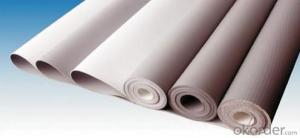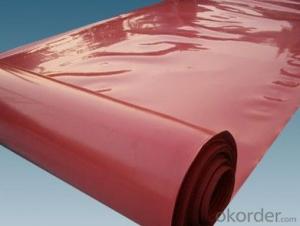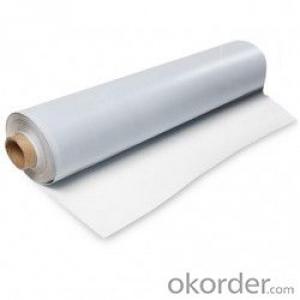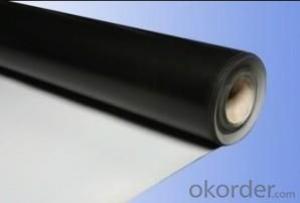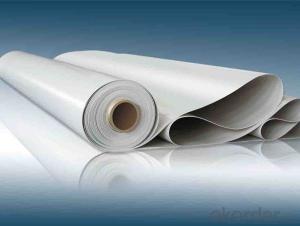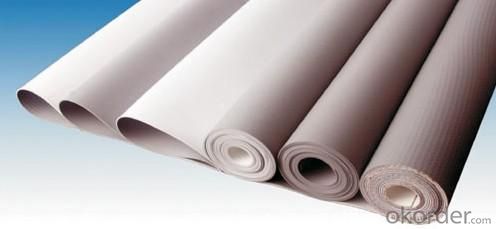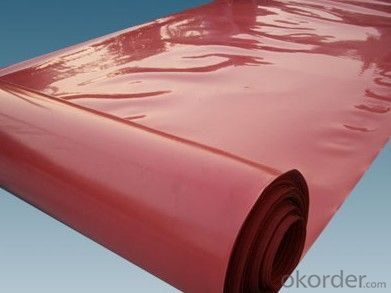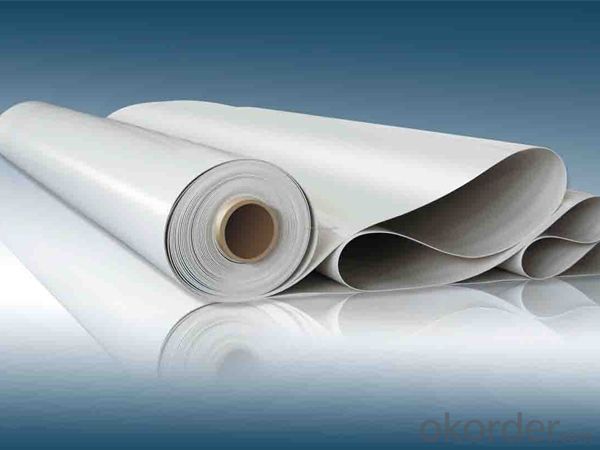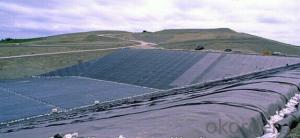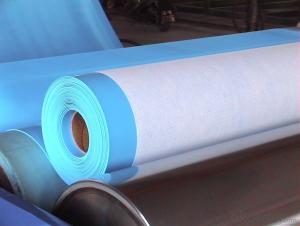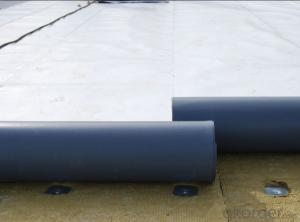TPO Roofing Waterproof Membrane with Superior Material
- Loading Port:
- Qingdao
- Payment Terms:
- TT or LC
- Min Order Qty:
- 20000 m²
- Supply Capability:
- 600000 m²/month
OKorder Service Pledge
OKorder Financial Service
You Might Also Like
The Advantages Of TPO Roofing Waterproof Membrane with Superior Material:
1. Weather resistance and durability
2. Excellent weldability
3. No any crisp agents to prevent materials brittleness
4. Intermediate enhanced polyester mesh fabric to have high tensile strength, fatigue resistance and penetrating resistance suitable for mechanically attached roofing systems
5. Excellent high and low temperature resistance the same as rubber materials which can keep flexible at -50 degree and keep mechanical strength in high temperature
6. Excellent chemical resistance to acids, bases, restaurant exhaust emissions, etc.
7. Dimension stability
8. White-based light-color and smooth surface with high reflection, energy saving and anti-dust functions
9. Use heat welding for the seam areas to form a reliable seamless waterproof layer
Applications of TPO Roofing Waterproof Membrane with Superior Material:
- Roof construction & steel structure of both industrial and civil engineering
- Underground engineering, such as subways, tunnels, air Raid shelter, etc.
- Sewage treatment, dam, reservoir and basement, grain storehouse, etc."
Technical Parameters of TPO Roofing Waterproof Membrane with Superior Material:
No. | Item | Index | |||
1 | mm≥ thickness of resin layer above inermediate tire mm ≥ | - | - | 0.4 | |
2 | tensile property | N/cm ≥ maximum tensile force N/cm ≥ | - | 200 | 250 |
MPa ≥ tensile Strength MPa ≥ | 12.0 | - | - | ||
≥ elongation at maximun tensile force% ≥ | - | - | 15 | ||
% ≥ elongation at fracture % ≥ | 500 | 250 | - | ||
3 | size change rate under heat treatment %≤ | 2.0 | 1.0 | 0.5 | |
4 | flexibility at low temperature | no crack at -40°c | |||
5 | unpermeability | 0.3Mpa,2h waterproof | |||
FRQ:
What is your main market?
Our Tpo Roofing Membrane with Superior Raw Material for Roofing Market sells very well in USA, United Kingdom, Austrilia, Canada, Japan, Pakistan, etc.
What is your advantage for Tpo Roofing Membrane?
With the most advanced production line, our good quality is based on superior material imported from America. We have different color available and could produce any color you want.
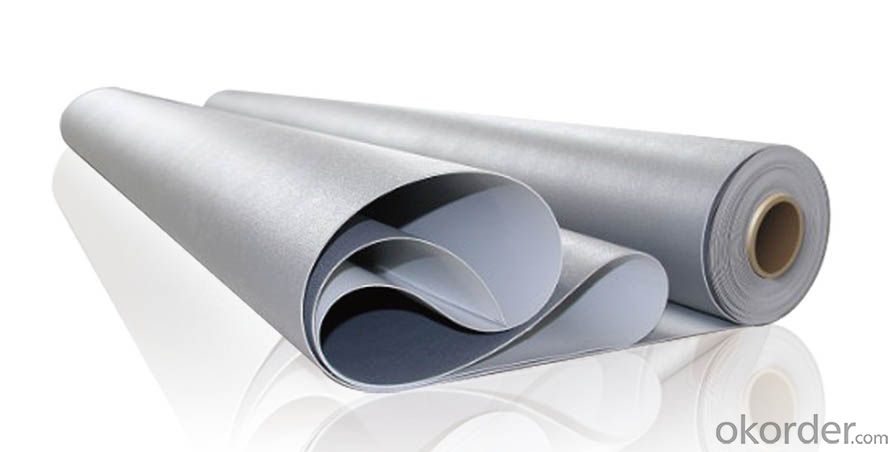

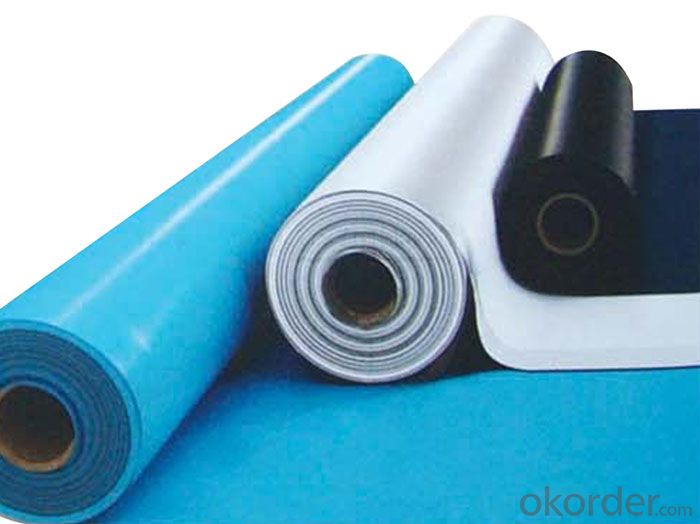
- Q: Can a waterproofing membrane be used on tunnels with historical significance?
- Yes, a waterproofing membrane can be used on tunnels with historical significance. The use of a waterproofing membrane is a common method to prevent water infiltration and damage in tunnels, regardless of their historical significance. It is crucial to protect these tunnels from water damage, as moisture can lead to deterioration, structural issues, and even collapse over time. However, when working with tunnels of historical significance, it is important to take additional precautions to preserve their historical integrity. This may involve using a waterproofing membrane that is visually compatible with the tunnel's original materials, ensuring that the installation does not disrupt or damage any historical features, and obtaining the necessary permissions, permits, and approvals from relevant historical preservation authorities. By following these guidelines, it is possible to effectively waterproof tunnels with historical significance while also preserving their historical and cultural value.
- Q: Can a waterproofing membrane be used in tunnels or underground structures?
- Yes, a waterproofing membrane can be used in tunnels or underground structures. Waterproofing membranes are designed to create a barrier against water penetration, making them effective in preventing water ingress in underground environments. These membranes are commonly used in tunnel construction to protect against moisture and water-related damages.
- Q: Can a waterproofing membrane be used in conjunction with fire protection systems?
- Indeed, the utilization of a waterproofing membrane in tandem with fire protection systems is possible. Although the primary function of a waterproofing membrane is to prevent water infiltration, it can also serve as an additional safeguard against fire hazards. Numerous waterproofing membranes are engineered to possess fire-resistant qualities or exhibit fire-retardant characteristics. Consequently, they aid in impeding the spread of fire and minimizing its impact on the edifice. Furthermore, certain waterproofing membranes are specifically tailored for integration into fire protection systems, such as fire-rated roof membranes or fire-resistant sealants. These specialized membranes effectively seal off potential avenues for fire and establish a barrier to safeguard the underlying structure. In summary, the incorporation of a waterproofing membrane alongside fire protection systems contributes to the overall enhancement of a building's safety and security.
- Q: Can a waterproofing membrane be used in conjunction with energy-efficient building designs?
- Indeed, energy-efficient building designs can benefit greatly from the utilization of a waterproofing membrane. By integrating this membrane into the construction process, numerous advantages can be achieved. To begin with, the presence of a waterproofing membrane plays a vital role in shielding the building envelope from water infiltration. This aspect is crucial as it ensures the structure's integrity and longevity. By preventing water damage, the building is able to avoid costly repairs and potential energy losses caused by moisture intrusion. Moreover, a well-designed waterproofing system can contribute significantly to the energy efficiency of the building by minimizing the reliance on mechanical heating and cooling. By effectively blocking moisture from entering the building envelope, the waterproofing membrane helps to maintain a consistent indoor temperature. Consequently, this reduces the burden on HVAC systems and enhances overall energy efficiency. Furthermore, specific types of waterproofing membranes possess reflective or heat-resistant properties that can further contribute to energy savings. These membranes are capable of reflecting solar radiation, thereby diminishing the amount of heat absorbed by the building. As a result, the demand for cooling is reduced. Lastly, it is important to note that waterproofing membranes can be seamlessly integrated with other energy-efficient building components such as green roofs or rainwater harvesting systems. These additional systems not only aid in reducing energy consumption but also provide insulation, decrease stormwater runoff, and promote sustainable water management practices. Overall, the incorporation of a waterproofing membrane in energy-efficient building designs elevates both the durability and energy performance of the structure. It offers protection against water damage, lessens the load on mechanical systems, and can be harmoniously integrated with other sustainable features, thus making it a highly valuable component of energy-efficient building designs.
- Q: Are waterproofing membranes suitable for high-traffic areas?
- Yes, waterproofing membranes are suitable for high-traffic areas. Waterproofing membranes are designed to provide a protective barrier against water infiltration, preventing water damage and maintaining the integrity of the structure. High-traffic areas, such as walkways, driveways, parking lots, and other heavily used spaces, are prone to constant exposure to water, which can lead to structural damage and deterioration over time. By applying a waterproofing membrane, these areas can be effectively protected from water intrusion, ensuring their durability and longevity. Additionally, waterproofing membranes are often designed to be slip-resistant, providing an added safety feature in high-traffic areas. Therefore, using waterproofing membranes in high-traffic areas is a wise choice to mitigate water-related issues and maintain the structural integrity of the space while ensuring the safety of occupants.
- Q: Can waterproofing membranes be used on underground tunnels?
- Yes, waterproofing membranes can be used on underground tunnels. These membranes are specifically designed to provide protection against water infiltration and can be applied to the tunnel walls and floors to prevent water ingress. The membranes create a barrier that keeps the tunnel dry, ensuring its structural integrity and preventing damage from moisture.
- Q: How does a waterproofing membrane handle movement or settling of a building?
- A building's movement or settling can be accommodated by a waterproofing membrane in several ways. Firstly, the membrane is typically installed in a manner that allows it to stretch or flex as the building moves. This elasticity ensures that the membrane remains intact and continues to provide a watertight seal, even if the structure shifts or settles. In addition, waterproofing membranes often include reinforcement materials, such as fabrics or fibers, which enhance their ability to withstand movement. These reinforcements help distribute the stress or strain caused by building movement across a larger area, reducing the risk of tears or failures in the membrane. Moreover, certain waterproofing membranes are designed with built-in features that can handle significant movement. For instance, some membranes possess special "crack-bridging" properties, enabling them to span small cracks that may develop in the building's substrate due to settling. This ensures that the membrane remains effective, even if the structure sustains minor damage. In cases where a building is expected to experience significant movement or settling, specialized waterproofing systems, such as joint sealants or expansion joints, may be used in conjunction with the membrane. These systems are specifically designed to handle large or dynamic movements, providing additional protection against water infiltration. Overall, careful design and installation of a waterproofing membrane enable it to effectively handle a building's movement or settling. Its elasticity, reinforcement materials, and additional features ensure that it maintains a watertight seal, even when faced with structural shifts or settlement.
- Q: Can waterproofing membranes be used on shower walls?
- Yes, waterproofing membranes can indeed be used on shower walls. In fact, they are an essential component of shower construction to prevent water leakage and potential damage to surrounding areas. Waterproofing membranes create a barrier that prevents water from seeping through the walls and into the structural components of the shower. They are typically installed behind the tile or other wall covering materials to provide an extra layer of protection. Waterproofing membranes are designed to be flexible, durable, and resistant to moisture, ensuring that the shower walls remain watertight and free from any potential water damage.
- Q: Can a waterproofing membrane be used on tunnels with water drainage systems?
- Yes, a waterproofing membrane can be used on tunnels with water drainage systems. A waterproofing membrane is designed to provide a protective barrier against water penetration and can effectively prevent water leakage into the tunnel. However, it is important to ensure that the waterproofing membrane is compatible with the specific water drainage system in place. The membrane should be installed in such a way that it does not obstruct or interfere with the functioning of the drainage system. Additionally, proper consideration should be given to the design and installation of the drainage system to ensure efficient water management and prevent any potential issues that could compromise the effectiveness of the waterproofing membrane. Overall, with proper planning and installation, a waterproofing membrane can be successfully used in tunnels with water drainage systems to ensure the overall integrity and longevity of the structure.
- Q: Can a waterproofing membrane be used in schools or educational buildings?
- Certainly, schools and educational buildings can certainly make use of waterproofing membranes. These membranes are specifically engineered to halt water infiltration and safeguard the structural integrity of the building against moisture-related harm. In educational settings, where numerous students and staff congregate, it becomes imperative to uphold a secure and hygienic environment. Waterproofing membranes can be effectively deployed in a variety of areas like basements, roofs, walls, and foundations to avert water seepage, dampness, and the proliferation of mold. By incorporating a waterproofing membrane into their infrastructure, schools can ensure the long-term sustainability of their buildings, safeguard valuable equipment and resources, and furnish a comfortable learning atmosphere for students and staff.
Send your message to us
TPO Roofing Waterproof Membrane with Superior Material
- Loading Port:
- Qingdao
- Payment Terms:
- TT or LC
- Min Order Qty:
- 20000 m²
- Supply Capability:
- 600000 m²/month
OKorder Service Pledge
OKorder Financial Service
Similar products
Hot products
Hot Searches
Related keywords

